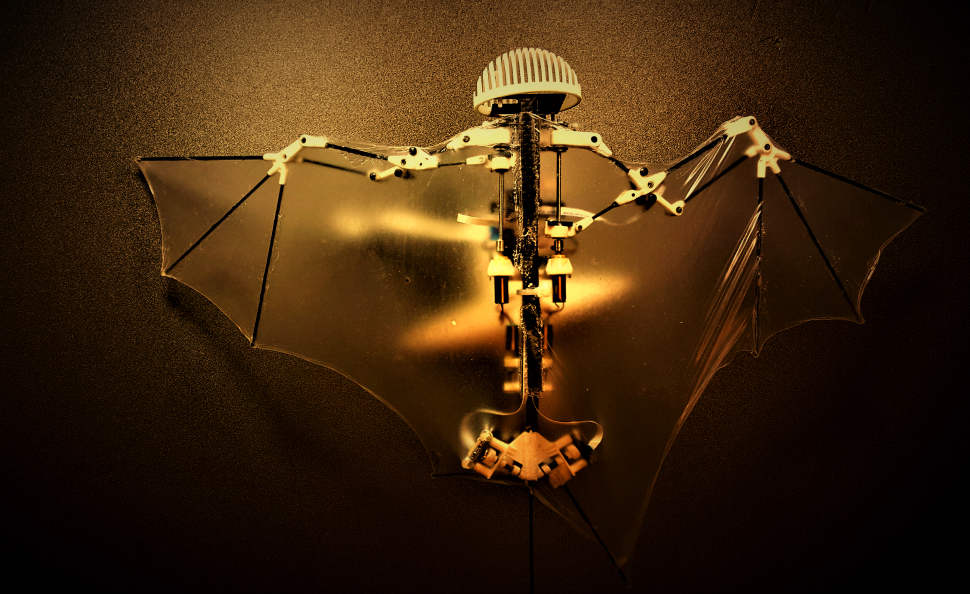Eli Kaberon, March 4, 2017
A trio of researchers at the University of Illinois has developed a robot that flies.
It also resembles a bat.
That?s right: a flying robot bat.
In addition to sounding like something out of a comic book, the flexible autonomous robot with wings and a body type similar to a bat has several scientific and practical applications and recently earned a spot on the cover of Science Robotics.
BTN LiveBIG caught up with two of the researchers on the project - postdoctoral researcher Alireza Ramezani and advisor Seth Hutchinson - both with the Coordinated Science Laboratory – to discuss how Bat Bot was created and why it could eventually help personal safety in one specific industry.
BTN LiveBIG: What was the inspiration and need for developing a robot that can simulate the flight of bats?
Alireza Ramezani: Mainly there were two motivations: Our first was deploying this platform to construction zones, monitoring workers. And helping understand how biological bats can fly.
Seth Hutchinson: And both of us were pretty excited right off the bat at the possibility of building a robot bat.
BTN LiveBIG: One of the many amazing aspects of Bat Bot is its ability to fly autonomously. How were you able to develop the technology to be able to do that?
AR: It?s amazing how these days you can have access to inexpensive electronics. One of my jobs as a system engineer is to find all these resources and put them together and kind of come up with a communication protocol to connect all these devices. Bat Bot has an onboard computer that at the same time communicates with multiple sensors. It?s really about electronic technology and the powerful state of the art electronics that are available these days for system engineers.
SH: The autonomy that we are able to have now in the bat robot is certainly not the type of full autonomy where the robot can speculate about its future and figure out how to achieve its lifelong goals. It?s much more at the lower level of figuring out what it needs to do with its motors when it flies through the air without falling out of the sky.
BTN LiveBIG: What benefit will the Bat Bot provide for the construction industry?
SH: The bat robot can have a pretty wide range of applications, but we were driven at the beginning particularly by the construction application. There are two main reasons: One of the reasons is that construction sites are complicated and they don?t always progress the way a plan indicates they should progress. So making sure on a daily basis that what got built is the same as what should be built – that?s a problem that construction site managers have to deal with.
I think the stronger motivation is the humanitarian aspect. A lot of people die every year on construction sites and even more are injured. I think quite often those accidents are the result of human beings not being fully aware of their environment. Things are happening overhead with cranes carrying heavy payloads. So we imagined that in addition to monitoring the evolution of the construction process, the bat robot could also be of use seeing what the humans are doing in relation to what the heavy machinery is doing, and give some sort of warning in situations where humans might wander into danger inadvertently.
BTN LiveBIG: What is the future of bat robot technology for you and your team?
AR: When you look at actual biological bats, their wings have 40 degrees of freedom and 40 moveable joints, actively collaborating in flight mechanics. What surprises me is that they use all these 40 joints, and then each wing bends. [It happens in] less than one-hundredth of a millisecond compared to other species. None of the abstract actuators that are available out there can match the bat?s actuation. That would probably be a future development, especially for electrical engineers, to do that and see if they can push the boundaries.
SH: What we have at this moment is a robotic prototype that can do things; what we also have is a stack of papers of equations that describe what we think the robot should be able to do. We?re about to enter the stage of making those two things come together, the mechanical system and the mathematical modeling system, to see really how far [we] can push things. We have these models that in some sense, given the limitations of what is possible, some of those models are too complicated to use in real life.
BTN LiveBIG: Why was being at the University of Illinois so vital for this project?
AR: For me personally, this problem is a very complex mathematical problem and requires very sophisticated math to be able to model the mechanics of biological bats. Understanding simply how bats fly from a control perspective is just a major motivation. Of course there are tools that are available at top programs. U of I has been a perfect place to have access to all these amazing tools. The university has one of the top major electronic engineering computer science programs in the nation, and that has been significantly helpful. Major engineering programs and easy access to smart students. So it?s really about if you have access to the right tools, and at U of I we have had access to all those tools.







 Check out what's coming up on B1G+ and subscribe to watch for more live events.
Check out what's coming up on B1G+ and subscribe to watch for more live events. 